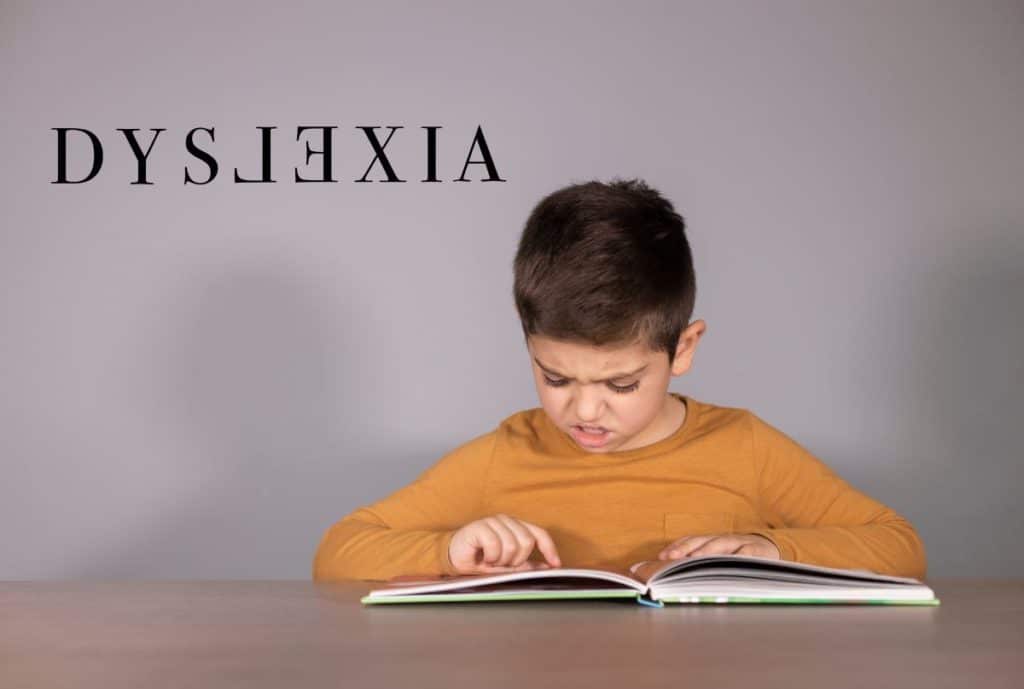
When learning to read, children may mistake certain letters for other similar ones, especially those that can be reversed or appear the same when seen in a mirror. The child may read dog as bog or look at the written word was and read it as saw. These errors are called letter reversals and mirror writing. Are they signs of dyslexia?
“Totally normal” in young readers
Learning lowercase letters can be confusing for many children, especially the letters b, d, p, and q. When you think about it, it’s not surprising that kids often mix them up. After all, most objects don’t change what they are just because you flip them around or turn them upside down!
Letter reversals and mirror writing experienced by young children are often said to be “totally normal” until after age seven, and their parents are told not to worry unless they continue past second grade.
This appears to be accepted as fact, but it raises questions: If your child were saying, “I eated my lunch,” would you immediately model the correct grammar, or would you not worry about it until after age seven? If your child were practicing a math fact, “2+3 = 8,” would you correct them or not worry and wait until their seventh birthday? Are letter reversals different?
When letter reversals and mirror writing are persistent
Unfortunately, children with dyslexia may continue with letter reversals and mirror writing when reading or writing. However, these are never the only symptoms of dyslexia; there are many other symptoms to consider:
• Poor ability to remember individual sounds or sequences of sounds.
• Cannot match the appropriate letter when given the sound.
• May try to sound a word’s letters but cannot say the correct word. For example, they may sound the letters’ c-a-t’ but then say cold.
• Puts letters in the wrong order, reading felt as left, act as cat, reserve as reverse, expect as except.
• Misreads little words, such as a for and, the for a, from for for, then for there, were for with.
• Loses orientation on a line or page while reading, causing them to miss lines or read previously reread lines.
• Reads aloud hesitantly, word by word, monotonously.
• Mispronounces words or puts stress on the wrong syllables.
• Foreshortens words, for example, ‘portion’ for proportion.
• Omits prefixes, omits or adds suffixes.
• Reads with poor comprehension.
• Remembers little of what they read.
• Often ignores punctuation, omitting full stops or commas.
What causes letter reversals and mirror writing?
Persistent letter reversals and mirror writing are usually the results of a visual processing deficit. Visual processing refers to the brain’s ability to perceive, interpret, and process what the eyes see.
The role of visual processing in dyslexia research has been greatly ignored over the last few decades in favor of the phonological deficit hypothesis. Children with good phonological skills, or good “phonological awareness,” become good readers and spellers. Phonological awareness refers to an individual’s awareness of a language’s phonological or sound structure. Conversely, children with poor phonological skills progress more poorly.
However, several studies show that people with dyslexia present a visual-processing deficit independently of phonological skills (Valdois et al., 2011). In a study by Georgiou et al. (2021), about half of the 21 children with dyslexia showed visual processing deficits. A study by Provazza et al. (2022) suggests that the impaired reading and associated deficits observed in dyslexia are anchored by impairments in both visual and phonological mechanisms that underpin reading.
Reversals of b and d are occasionally caused by a phonological processing deficit, specifically an inability to discriminate between the sounds ‘buh’ and ‘duh.’
Visual processing and letter reversals
Before one can learn anything, processing or perception must take place, i.e., one has to become aware through one of the senses. Usually, one must hear or see it. Subsequently, one has to interpret whatever one has seen or heard. Therefore, in essence, processing or perception means interpretation.
Of course, a lack of experience may cause a person to misinterpret what they have seen or heard. In other words, processing represents our apprehension of a present situation in terms of our past experiences, or, as stated by the philosopher Immanuel Kant in Critique of Pure Reason (1781): “We see things not as they are but as we are.”
The following situation illustrates how processing correlates with previous experience:

Suppose a person parks his car and walks away from it while continuing to look back at it. As they move further and further away from their car, it will appear to them as if their vehicle is gradually becoming smaller and smaller. However, in such a situation, none of us would gasp in horror and cry out, “My car is shrinking!”
Although the sensory image of the car is shrinking rapidly, we do not interpret that the car is changing size. Past experiences have taught us that objects do not grow or shrink as we walk toward or away from them. We have learned that their actual size remains constant despite the illusion. Even when one is five blocks away from one’s car, and it seems no larger than one’s fingernail, one’s interpretation would be that it is still one’s car and hasn’t changed size. This learned perception is known as size constancy.
Pygmies, however, who used to live deep in the rain forests of tropical Africa, were not often exposed to wide vistas and distant horizons and, therefore, did not have sufficient opportunities to learn size constancy. Colin Macmillan Turnbull, an anthropologist and author of The Forest People, wrote about one pygmy who, when removed from his usual environment, was convinced he saw a swarm of insects when he was looking at a herd of buffalo at a great distance. When driven toward the animals, he was frightened to see the insects “grow” into buffalo and was sure witchcraft had been responsible.
To summarize, one must have had enough exposure to wide vistas and distant horizons to interpret size constancy. In the same way, to interpret position-in-space — the learned perception that makes it possible to distinguish a b from a d — one must have had enough exposure to relevant experiences. Relevant experiences include the ability to distinguish left and right and the ability to cross the midline.
The human body consists of two halves: a left side and a right side. The human brain also has two halves connected by the corpus callosum. Mindful of the wise words of Immanuel Kant that man does not see things as they are but as he or she is, it is inevitable that a person will interpret everything in terms of their sidedness. Children who have not yet learned to correctly interpret in terms of their sidedness, who have not learned to distinguish properly between left and right, will inevitably experience problems when they find themself in situations where they are expected to interpret sidedness.
One such situation where sidedness is critical is when a child must distinguish between a b and a d. The only difference between the two letters is the position of the straight line. It is either left or right.
Memory aids don’t work
It is important to note that people confused about left and right cannot use menmonics or memory aids while reading, as is often advised. Children, for example, are often advised to remember that “left” is the side on which they wear their watch.
Another commonly used trick to remember the direction of b and d is to show the child the word “bed” on a card.

Then, ask them to hold their hands in front of the card, form their first finger and thumb into a ring, and point the other three fingers straight up to mimic the shapes of the letters. Help them to sound out the word “bed” while noticing that b and their left hand start the word while d and their right hand finish it.
This trick never works to improve reading ability. It can be compared to learning a language. One cannot speak a foreign language if one only has a dictionary in that language. One has to learn to speak it. In the same way, one has to learn to interpret sidedness. As with all the other skills foundational to reading, the ability to distinguish between left and right must be drummed in so securely that the person can apply it during reading and writing without thinking of it.
How can Edublox help?
Edublox Online Tutor is an online platform that houses products and services to improve various aspects of learning. Live Tutor combined with Development Tutor is recommended for students with mild to severe dyslexia and aims at
- strengthening cognitive skills, including position-in-space;
- teaching decoding, a key skill for learning to read that involves taking apart the sounds in words (segmenting) and blending sounds together, and
- developing orthographic mapping.
Watch the playlist below and experience how Edublox training and tutoring help turn dyslexia around. Book a free consultation to discuss your child’s learning needs.
Authored by Susan du Plessis (B.A. Hons Psychology; B.D.), an educational specialist with 30+ years’ experience in the learning disabilities field.
.
References and sources:
Dworetzky, J. P. (1981). Introduction to child development. St. Paul: West Publishing Company.
Georgiou, G. K., Papadopoulos, T. C., Zarouna, E., Parrila, R. (2012). Are auditory and visual processing deficits related to developmental dyslexia? Dyslexia, 18(2): 110-29.
Hornsby, B. (1984). Overcoming dyslexia. Johannesburg: Juta and Company Ltd.
Provazza, S., Carretti, B., Giofrè, D. et al. (2022). Shallow or deep? The impact of orthographic depth on visual processing impairments in developmental dyslexia. Annals of Dyslexia, 72.
Turnbull, C. M. (1961). Some observations regarding the experiences and behavior of the Bambuti Pygmies. American Journal of Psychology, 74.
Valdois, S., Bidet-Ildei, C., Lassus-Sangosse, D. et al. (2011). A visual processing but no phonological disorder in a child with mixed dyslexia. Cortex, 47(10).
